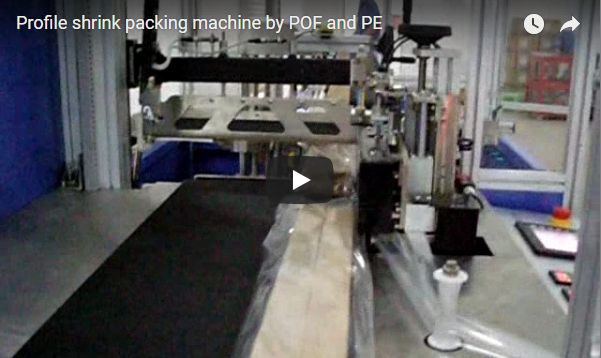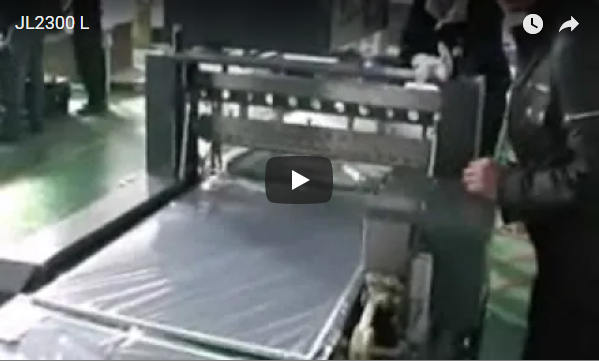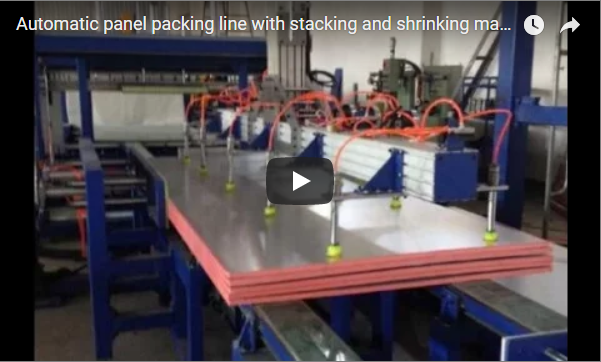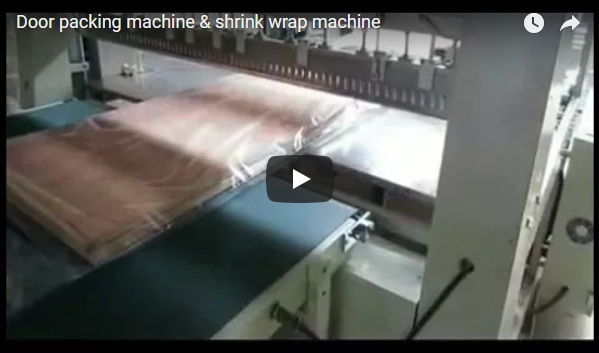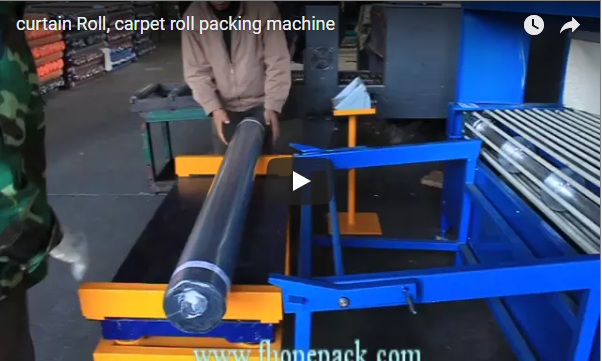Automatic Panel Shrink Packing Machine: A Technical Deep Dive
Packaging large, flat products like wooden panels, doors, insulation boards, or furniture components presents unique challenges. Ensuring these items are protected from environmental factors, handling damage, and tampering while maintaining a professional appearance requires specialized solutions. Automatic panel shrink packing machines offer an efficient, reliable, and cost-effective method to achieve these goals.
This article delves into the technical aspects, operational principles, and benefits of utilizing automatic shrink wrapping systems specifically designed for large panel-type products.
1. What is an Automatic Panel Shrink Packing Machine?
An Automatic Panel Shrink Packing Machine is an industrial packaging system designed to fully enclose large, typically flat or relatively thin products within a layer of plastic shrink film. The process involves automatically sealing the film around the product and then applying heat via a shrink tunnel, causing the film to conform tightly to the product's shape. These machines are engineered to handle significant product dimensions and weights, integrating seamlessly into automated production lines. Common configurations include side sealers for continuous motion or L-bar sealers, depending on speed requirements and product flow.
2. Key Features and Components Breakdown
Understanding the core components provides insight into the machine's functionality and capabilities:
- Infeed Conveyor: Transports panels into the wrapping station. Often equipped with sensors for product detection and positioning.
- Film Delivery System: Typically uses two rolls of film (top and bottom) or a center-folded roll. Includes motorized unwinds and tension control for consistent film feeding.
- Sealing System:
- Side Sealer: Creates a continuous longitudinal seal as the product moves through. Ideal for products of varying lengths and higher speeds. Often employs heated wheels or belts.
- Cross Sealer: Creates the front and rear seals perpendicular to the product flow, separating individual packs. Can be a hot knife, L-bar, or intermittent motion sealing bar.
- Heat Shrink Tunnel: An insulated chamber with controlled heating elements and air circulation fans. Applies uniform heat to shrink the film tightly around the panel. Temperature and conveyor speed are adjustable based on film type and thickness.
- Outfeed Conveyor: Transports the finished, shrink-wrapped panel out of the machine, often incorporating cooling fans to set the film quickly.
- Control System: Typically features a Programmable Logic Controller (PLC) for process automation and a Human-Machine Interface (HMI) (touchscreen) for parameter adjustments, recipe storage, and diagnostics.
- Safety Features: Emergency stop buttons, safety interlocks on access doors/guards, and sensors to prevent collisions or improper operation.
3. Technical Specifications Overview (Typical Ranges)
Specifications vary significantly based on manufacturer and model, but here’s a representative data comparison:
- Maximum Panel Dimensions (L x W x H): 2500-6000mm x 1200-2000mm x 50-200mm
- Packing Speed: 4 - 12 packs per minute (highly dependent on panel size, film type, and sealing method)
- Applicable Film Types: Polyethylene (PE), Polyolefin (POF) - PE is common for bundling and robustness, POF for clarity and retail presentation. [Link to technical data sheet on PE vs POF film - placeholder for credible external link]
- Film Thickness Range: 25 - 100 microns (0.025mm - 0.1mm)
- Sealing Technology: Constant heat side seal / Hot knife cross seal (common configuration)
- Tunnel Temperature Range: Adjustable, typically 140°C - 230°C
- Power Requirements: 380V/415V, 3 Phase, 50/60Hz (Consumption varies greatly, 20kW - 60kW+ depending on tunnel size)
- Compressed Air Requirement: 6 - 8 bar (for pneumatic actuators, if used)
- Control System: PLC (e.g., Siemens, Allen-Bradley) with Color Touchscreen HMI
4. How it Works: The Operational Process
The automatic panel shrink wrapping cycle typically follows these steps:
- Product Infeed: The panel is placed onto the infeed conveyor, either manually or via an upstream automated system.
- Positioning: Sensors detect the panel's leading edge, initiating the wrapping cycle. The conveyor moves the panel into the film curtain.
- Film Encasement: The film is automatically drawn from the top and bottom rolls (or folded from a single roll) to envelop the panel.
- Side Sealing (if applicable): As the panel continuously moves, the side sealing mechanism creates a longitudinal seal along the panel's length.
- Cross Sealing: The cross-sealing bar descends, sealing the film at the front of the current panel and the back of the preceding panel, simultaneously cutting the film to separate the packs.
- Transfer to Tunnel: The conveyor speeds up slightly to create separation and transfers the loosely film-wrapped panel into the heat shrink tunnel.
- Heat Application: Inside the tunnel, precisely controlled hot air circulates around the panel, causing the shrink film to shrink uniformly and tightly conform to the product's contours.
- Cooling & Exit: The wrapped panel exits the tunnel onto an outfeed conveyor, where ambient air or forced air cooling helps solidify the film quickly.
5. Design and Structural Considerations
Designing robust automatic panel shrink wrappers involves several key considerations:
- Frame Rigidity: The machine frame must be heavy-duty to support large, heavy panels and withstand continuous operation without vibration affecting seal quality.
- Conveyor System: Belts or rollers must be suitable for the panel weight and surface to prevent damage and ensure smooth transfer. Variable speed control is essential.
- Sealing Precision: Alignment and consistent temperature/pressure of sealing elements are critical for strong, aesthetically pleasing seals, especially on large surface areas.
- Tunnel Efficiency: Proper insulation, airflow design, and heating element placement are crucial for uniform shrinking and energy efficiency.
- Film Handling: Easy loading of large, heavy film rolls and reliable tension control are important ergonomic and operational factors.
- Modularity & Integration: Designs often allow for modular additions (e.g., labeling, stacking units) and easy integration with existing production lines.
6. Common Applications
These machines are indispensable in industries dealing with large-format products:
- Woodworking: Doors, furniture panels (MDF, particleboard), tabletops, flooring planks.
- Building Materials: Drywall sheets, insulation boards, roofing panels, siding.
- Metal Fabrication: Large sheet metal parts, access panels.
- Automotive: Large replacement parts, body panels (prior to painting).
- Other: Mattresses (some specialized models), large picture frames, assembled flat-pack furniture.
7. Benefits of Automating Panel Shrink Wrapping
Transitioning to or implementing automatic panel shrink wrapping provides significant advantages:
- Increased Throughput: Significantly faster than manual or semi-automatic methods.
- Consistent Quality: Uniform wrapping and sealing for every panel.
- Enhanced Product Protection: Creates a barrier against dust, moisture, scratches, and minor impacts during transit and storage.
- Reduced Labor Costs: Frees up personnel previously engaged in manual wrapping for other tasks.
- Improved Load Stability: Tightly wrapped panels are often more stable for stacking and handling.
- Professional Appearance: Provides a clean, tamper-evident presentation.
- Reduced Material Waste: Precise film usage compared to manual methods.
[Link to PMMI or similar industry article on packaging automation benefits - placeholder for credible external link]
8. Personal User Experience & Practical Considerations
From an operational standpoint, maximizing the value of an automatic panel shrink wrapper involves:
- Film Selection is Key: Choosing the correct film type (PE for strength, POF for clarity), thickness (balancing protection vs. cost), and shrink characteristics is crucial. Test different films for optimal results with your specific panels.
- Preventative Maintenance: Regularly inspect and clean sealing elements (residue buildup impacts seal quality), check conveyor belts/chains, lubricate moving parts, and monitor tunnel heating elements and airflow. Adhere strictly to the manufacturer's recommended maintenance schedule.
- Operator Training: Ensure operators are fully trained on machine operation, safety procedures, film loading, HMI navigation, and basic troubleshooting (e.g., clearing film jams, adjusting temperature/speed for different products).
- Parameter Optimization: Fine-tuning conveyor speed, tunnel temperature, and sealing times for different panel sizes and film types is essential for achieving the perfect balance between wrap quality, speed, and energy consumption. Keep a log of optimal settings (recipes) in the HMI.
- Environmental Factors: Ambient temperature and humidity can sometimes affect film performance and tunnel efficiency. Be aware of significant environmental changes.
- Integration Planning: Consider upstream and downstream processes. Ensure smooth handoffs between machines and adequate accumulation space if line speeds vary.
Conclusion: Investing in Efficiency and Protection
Automatic panel shrink packing machines represent a vital technology for industries producing large, flat goods. By automating the wrapping process, businesses can achieve significant gains in operational efficiency, product protection, packaging consistency, and overall presentation. The technical sophistication, robust design, and adaptability of modern systems make them a valuable investment for optimizing the packaging leg of the supply chain. When selecting a machine, carefully evaluating technical specifications, component quality, manufacturer support, and aligning capabilities with specific application needs is paramount to realizing the full benefits of this automation.
[Link to internal Contact Us page for quotes or inquiries - placeholder for internal link]
[Link to internal category page for other Shrink Wrapping Equipment - placeholder for internal link]

